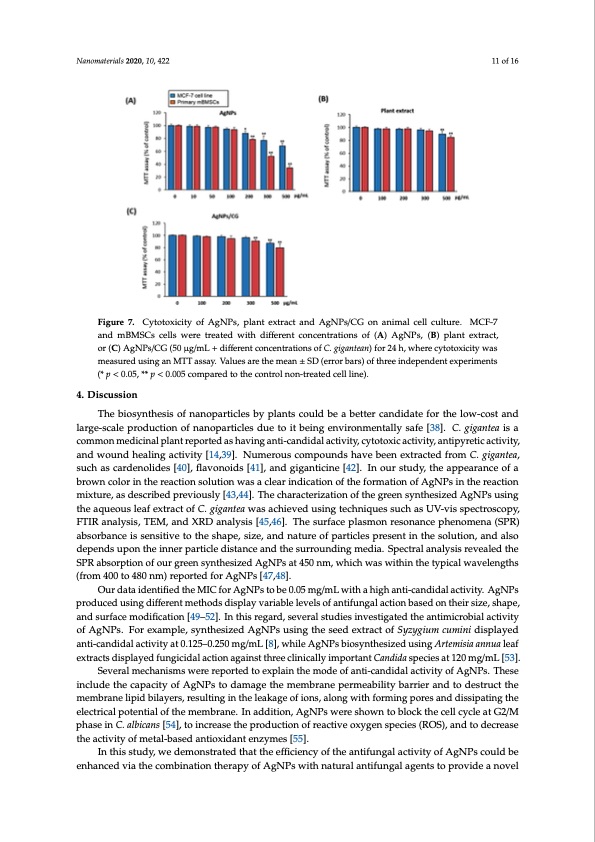
PDF Publication Title:
Text from PDF Page: 011
Nanomaterials 2020, 10, 422 11 of 16 Figure 7. Cytotoxicity of AgNPs, plant extract and AgNPs/CG on animal cell culture. MCF-7 and mBMSCs cells were treated with different concentrations of (A) AgNPs, (B) plant extract, or (C) AgNPs/CG (50 μg/mL + different concentrations of C. gigantean) for 24 h, where cytotoxicity was measured using an MTT assay. Values are the mean ± SD (error bars) of three independent experiments (* p < 0.05, ** p < 0.005 compared to the control non-treated cell line). 4. Discussion The biosynthesis of nanoparticles by plants could be a better candidate for the low-cost and large-scale production of nanoparticles due to it being environmentally safe [38]. C. gigantea is a common medicinal plant reported as having anti-candidal activity, cytotoxic activity, antipyretic activity, and wound healing activity [14,39]. Numerous compounds have been extracted from C. gigantea, such as cardenolides [40], flavonoids [41], and giganticine [42]. In our study, the appearance of a brown color in the reaction solution was a clear indication of the formation of AgNPs in the reaction mixture, as described previously [43,44]. The characterization of the green synthesized AgNPs using the aqueous leaf extract of C. gigantea was achieved using techniques such as UV-vis spectroscopy, FTIR analysis, TEM, and XRD analysis [45,46]. The surface plasmon resonance phenomena (SPR) absorbance is sensitive to the shape, size, and nature of particles present in the solution, and also depends upon the inner particle distance and the surrounding media. Spectral analysis revealed the SPR absorption of our green synthesized AgNPs at 450 nm, which was within the typical wavelengths (from 400 to 480 nm) reported for AgNPs [47,48]. Our data identified the MIC for AgNPs to be 0.05 mg/mL with a high anti-candidal activity. AgNPs produced using different methods display variable levels of antifungal action based on their size, shape, and surface modification [49–52]. In this regard, several studies investigated the antimicrobial activity of AgNPs. For example, synthesized AgNPs using the seed extract of Syzygium cumini displayed anti-candidal activity at 0.125–0.250 mg/mL [8], while AgNPs biosynthesized using Artemisia annua leaf extracts displayed fungicidal action against three clinically important Candida species at 120 mg/mL [53]. Several mechanisms were reported to explain the mode of anti-candidal activity of AgNPs. These include the capacity of AgNPs to damage the membrane permeability barrier and to destruct the membrane lipid bilayers, resulting in the leakage of ions, along with forming pores and dissipating the electrical potential of the membrane. In addition, AgNPs were shown to block the cell cycle at G2/M phase in C. albicans [54], to increase the production of reactive oxygen species (ROS), and to decrease the activity of metal-based antioxidant enzymes [55]. In this study, we demonstrated that the efficiency of the antifungal activity of AgNPs could be enhanced via the combination therapy of AgNPs with natural antifungal agents to provide a novelPDF Image | Inhibition of Candidiasis Calotropis Silver Nanoparticles

PDF Search Title:
Inhibition of Candidiasis Calotropis Silver NanoparticlesOriginal File Name Searched:
nanomaterials-10-00422-v3.pdfDIY PDF Search: Google It | Yahoo | Bing
Turbine and System Plans CAD CAM: Special for this month, any plans are $10,000 for complete Cad/Cam blueprints. License is for one build. Try before you buy a production license. More Info
Waste Heat Power Technology: Organic Rankine Cycle uses waste heat to make electricity, shaft horsepower and cooling. More Info
All Turbine and System Products: Infinity Turbine ORD systems, turbine generator sets, build plans and more to use your waste heat from 30C to 100C. More Info
CO2 Phase Change Demonstrator: CO2 goes supercritical at 30 C. This is a experimental platform which you can use to demonstrate phase change with low heat. Includes integration area for small CO2 turbine, static generator, and more. This can also be used for a GTL Gas to Liquids experimental platform. More Info
Introducing the Infinity Turbine Products Infinity Turbine develops and builds systems for making power from waste heat. It also is working on innovative strategies for storing, making, and deploying energy. More Info
Need Strategy? Use our Consulting and analyst services Infinity Turbine LLC is pleased to announce its consulting and analyst services. We have worked in the renewable energy industry as a researcher, developing sales and markets, along with may inventions and innovations. More Info
Made in USA with Global Energy Millennial Web Engine These pages were made with the Global Energy Web PDF Engine using Filemaker (Claris) software.
Infinity Turbine Developing Spinning Disc Reactor SDR or Spinning Disc Reactors reduce processing time for liquid production of Silver Nanoparticles.
| CONTACT TEL: 608-238-6001 Email: greg@infinityturbine.com | RSS | AMP |